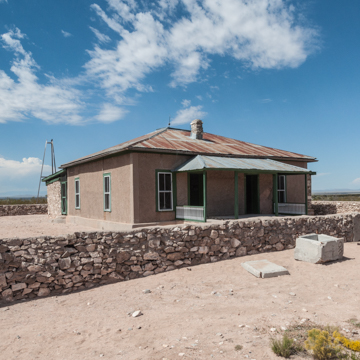The McDonald Ranch House is a humble dwelling where the core of the world’s first atomic bomb was assembled.
The McDonald clan homesteaded this corner of the Jornada del Muerto in the late nineteenth century, on land leased from the Territory (and later, the state) of New Mexico. In 1942, the ranches of David McDonald and George McDonald were leased to the federal government as part of the Alamogordo Bombing and Gunnery Range; in November 1944, they became part of the Trinity Test Site.
The David McDonald ranch house, at Camp Trinity ten miles south of Ground Zero, was abandoned when the camp buildings were dismantled after the test; the house has since been stabilized but remains closed to visitors. David MacDonald expected his ranch to be returned to him after the war and engaged in a forty-year battle with the U.S. Army when this did not happen.
The George McDonald ranch house is an east-facing, four-room adobe structure with a hipped, sheet metal roof. Built in 1913 by a German immigrant, Franz Schmidt, it was expanded by McDonald in the 1930s with stone additions to the north and west, and a low perimeter stone wall. Farther to the east he built an open water tank fed by a Chicago Aeromotor windmill, a stone bunkhouse and stone barn, and corrals and holding pens.
The house stood empty from 1942 until early 1945, when it was occupied by Trinity Site personnel. The master bedroom at the north-east corner of the house was converted into a clean room for assembling the bomb’s plutonium core. Workbenches and tables were set up, and the windows and doors were covered with plastic and tape to keep out the incessant dust. The house survived the nuclear explosion, which only blew out its windows, though the barn and bunkhouse suffered structural damage and have since collapsed into ruins. Abandoned after the test, the house deteriorated until the U.S. Army Corps of Engineers stabilized it in 1982. The National Park Service restored it in 1984 and again in 2014.
Located two miles southeast of Ground Zero, the George McDonald Ranch House can be visited during the annual open house on the first Saturday in April and October.
References
DeGroot, Gerald J. The Bomb: A Life. Cambridge, MA: Harvard University Press, 2005.
Greenwood, Richard, “Trinity Site,” Socorro County, New Mexico. National Register of Historic Places Registration Form, 1975. National Park Service, U.S. Department of the Interior, Washington, D.C.
Rhodes, Richard. The Making of the Atomic Bomb. New York: Simon and Schuster, 1986.
Seeber, Robert. The Los Alamos Primer: The First Lectures on How to Build An Atomic Bomb. Edited and introduction by Richard Rhodes. Berkeley: University of California, 1992.
Szasz, Ferenc Morton. The Day the Sun Rose Twice: The Story of the Trinity Site Nuclear Explosion July 16, 1945. Albuquerque: University of New Mexico, 1984.














